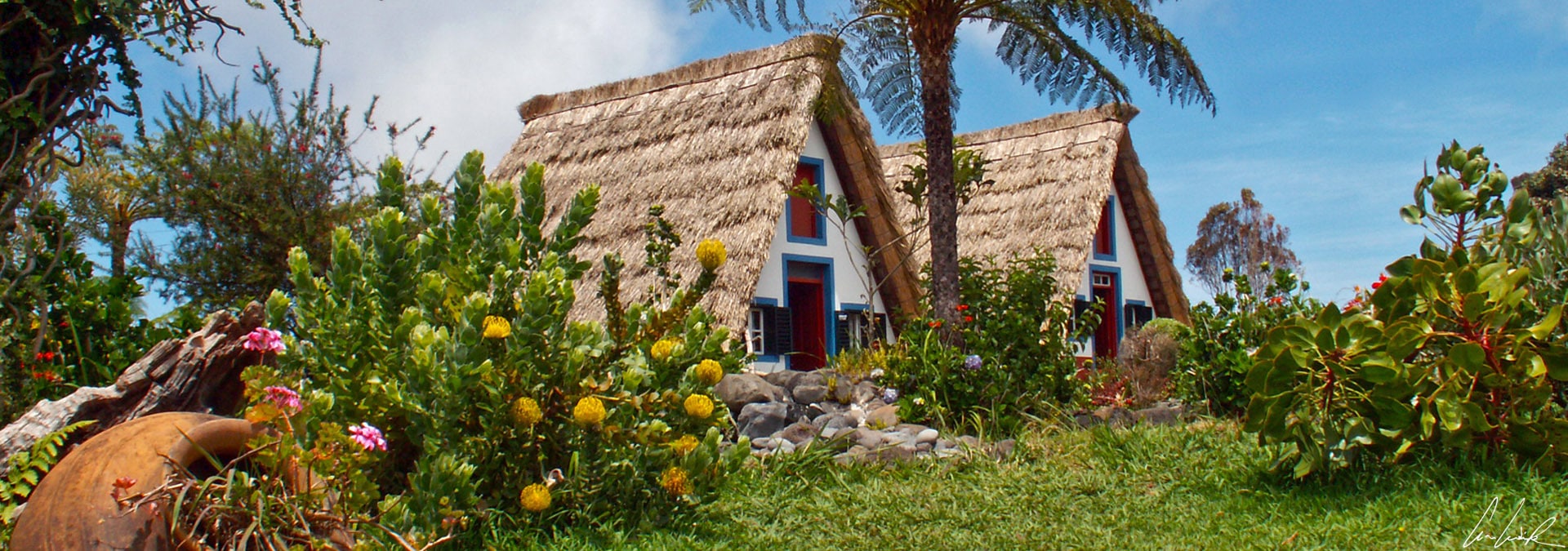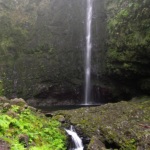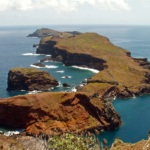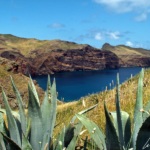Madeira Island presents such a diversity of landscapes that it is very difficult not to fall in love with its charm. If you are looking for a “nature” holiday where ocean and mountains meet, Madeira is for you ! Madeira Island, a true natural paradise, offers exuberant vegetation, volcanic mountains sculpted by erosion and unique, colorful villages. We love the contrast between the green of the peaks, the deep blue of the ocean and the white facades and red tiles of the houses. After hiking through spectacularly steep mountains and gasping at fabulous panoramas, imagine yourself paddling in one of the natural pools and lazing on the rocks! From São Lourenço, a wild peninsula, to the summit of Pico Ruivo, the highest point of the island, you move between ocean and mountains and from lush vegetation to rock cliffs…

Caldeirão Verde, a hike to go green
It’s hard to imagine a trip to Madeira without immersion in the dense forests that cover the island… Hiking in the Caldeirão Verde is spectacular. Over time, the water has cut imposing gorges and, ever-present, generates jungle-like vegetation along the walk. After passing in front of Santana’s marvelous thatched cottage, we are immediately absorbed in the lush subtropical greenery of the Laurisilva forest, a UNESCO World Heritage Site. Here, ferns are queens and laurels kings, and trees intertwine to create an atmosphere full of mysteries… However, how do trees and shrubs grow on the rocky cliffs ? In this phantasmagorical vegetable world, the water oozes from the plant-covered rocky walls and the ambient humidity pearls on our skin. You’d think you were “Cast Away”, a bit like Chuck Noland in his balloon Wilson, but as you listen, you can hear the sound of lapping water, the rubbing of leaves rocked by the wind and the singing of a few birds… All our senses are awakening! A bridge takes us over a small gorge with a 165-foot waterfall. After crossing a riverbed, some vertiginous passages lie partially hidden by a wall of vegetation. Then, the trail offers new surprises… On this part of the hike you need a flashlight to find your way through several low, narrow, wet tunnels. Take a deep breath and enjoy the smell of wet dirt and leaves. We finally reach an impressive gorge where the walls rise vertically towards the sky. A magnificent waterfall of about 230 feet high falls in the heart of the “Chaudron vert”. Swimming is for those not afraid of fresh water !

Discover the traditional houses of Santana
The small town of Santana lies on the north coast of the island nestled between ocean and mountains. Santana stands out from the other cities of Madeira by virtue of its colorful traditional stone houses with triangular-shaped thatched roofs… They reflect a time (not so long ago) when this form of construction was the only way to protect from the wet and cold northern wind. The rural houses of Santana (the “Casinhas de Santana”) also called “palheiros” (haylofts) have white-painted walls, red doors, and windows with blue trim. Scattered throughout the city, some are better preserved than others… The Centre for the Traditional Houses of Santana is a preservation area created by the municipality in honor of local building traditions. Most of these houses are tourist attractions where you can buy local products and traditional crafts, but they are also very photogenic ! When you venture into the village, wandering here and there, taking any bye-ways that strike your fancy, you pass traditional houses where people still live. However, most of the time they are no longer primary residences. These traditional houses consists of a habitable ground floor, usually a living room divided into two parts and an attic used to store agricultural products. The façade is often made of stone, but some older houses are of wood because they were designed to be movable. The inhabitants were poor farmers, and when they changed employers, they left with their houses on their backs, using poles and dozens of men… The thatched roof must be replaced every four or five years. The most complicated parts of this process are the “empenhas” (the facade side) and the “cumeeira” (the top of the roof.) The house then becomes comfortable and winter-resistant again! A “maranho” (bundle) of straw currently costs about 10 euros and to cover a house you need about a hundred…

Hiking on the rocky coast at the tip of São Lourenço
The Ponta de São Lourenço (Pointe of Saint Lawrence) is located at the easternmost point of Madeira. The terrain is unlike any other on the island, windswept by north winds and almost barren. This point is named after João Gonçalves de Zarco’s caravel, from which he discovered Madeira calling out:
« Ó São Lourenço, chega! » (Ho São Lourenço, stop here !) »
The São Lourenço hike follows the length of the peninsula in its length. It is one of the most popular and spectacular hikes on Madeira because the rocky landscape, beaten by strong winds, contrasts starkly with the green paths of the levadas: a labyrinth in different shades of green gives way to an arid and barren land mainly of ochre and red colors. In the natural reserve Ponta da São Lourenço, created in 1982, you have the impression of walking toward the end of the world surrounded by fabulous seascapes and rock formations testifying to the volcanic origin of the island. Along the route, you can see both the north and south coasts of the island. The semi-arid climate and the peninsula’s exposure to north winds explain the lack of trees. In this environment grows a rare low endemic vegetation. Of the 138 species of plant identified on the island, 31 are endemic to Madeira Island. The path follows the peninsula toward Pico do Furado, a twin peak with a circular rock window at its base above the waves. At the very easternmost tip of the peninsula “Là-bas / Où tout est neuf et tout est sauvage / Libre continent sans grillage” (There / Where everything is new, and everything is wild / a free, unfenced terrain) is your destination: the Cais do Sardinha named after its former owner. Along the way, you discover a wild and abrupt coastline. The volcanic sea cliffs are tinged with black, red and ochre hues and plunge into the rough ocean while rock structures with sharp points and extraordinary shapes seem to sprout out of the ocean. These rock formations result from the volcanic origin of the peninsula and are mostly of basalt with some limestone sediment. On the way to Pico do Furado, there is a 360° panoramic view across the peninsula and beyond to two islands separated from the point by a only a few hundred feet: Cevada (Ilhéu da Cevada) and Farol (Ilhéu de Farol). Farol is surmounted by a lighthouse, “le farol”, built in 1870 (the oldest lighthouse in Madeira). On the horizon, the island of Porto Santo can be seen to the north and Ilhas Desertas or Desertas Islands (Chao islet, Bugio island and Deserta Grande) to the southeast

From Pico Do Arieiro to Pico Ruivo: a hike to the summit
A scenic road takes us to the heart of the mountainous region of the island, to the Pico do Arieiro, at 5,965 feet the third highest peak of the Island. A spectacular trail begins at Pico do Arieiro and connects the three highest peaks of Madeira: Pico do Arieiro, Pico das Torres at 6,079 feet and Pico Ruivo at 6,109 feet, the highest mountain on the island. We start our journey to the highest summits of Madeira by passing through clusters of the violet flowers of Madeira viperine (Echium candicans) and Spanish broom (Spartium junceum.) We then reach the Miradouro Ninho da Manta, which offers a breathtaking view over the valley of Fajã de Nogueira. The entire footpath is paved from end to end and passes through tunnels and up steep slopes and stairs carved into the rock. We walk along precipices separated from a steep drop only by a railing of a single rope. Although the course is well secured, it is not for the faint-hearted or anyone suffering from vertigo. The path meanders through rock formations and as we progress we pass stunning panoramas and landscapes. We finally arrive at the Pico Ruivo lookout, which offers a fabulous and unobstructed view over the neighboring peaks. On a clear day, Pico Ruivo offers a 360°panoramic view on the island: the Nuns Valley, Porto Santo, and the Ilhas Desertas and the Ponta de São Lourenço in the distance. On most days, however, a layer of clouds will partially obscure the view ! For this hike, it is better to start early in the day. Around mid-day, the clouds come low down, fluffy, white and cotton-like… Even if Funchal and the south coast enjoy a nice cloudless sky, the interior of the island may be foggy and the North coast under clouds and rain…

Swimming in the natural pools of Porto Moniz
Porto Moniz is a charming little town perched on the northwest corner of Madeira and well known for its natural pools, formed by volcanic lava and filled naturally with crystal-clear seawater that reflects the azure of the sky. Porto Moniz is situated west of Santana and Machico and northwest of Funchal. Natural pools have formed in the black basalt rock and are filled by the mighty waves of the Atlantic Ocean. There are two distinct areas of seawater pools. The first setting is a total natural pool with sharp rocks overlooking the Ilheu Mole Island. The black basalt composing these pools is sharp, slippery and unforgiving if you trip… The second is a group of seawater pools developed for swimming, Piscinas Naturais do Porto Moniz. This pool is safer, especially for children, and there is a lifeguard. Porto Moniz is an exceptional place to spend a long afternoon relaxing near one of the seawater lava pools, swimming, and paddling. It is surrounded by hills offering breathtaking views over the town and the coastline, including the Mirador de Santa. Also not to be missed is the historic fort of João Batista, built in 1730 from basalt rocks to protect against pirate attacks. The old fort has been restored to house the Madeira’s aquarium and is home to over 70 species of fish from the waters of the archipelago.
Find more on Madeira
- Madeira: Stopover in Funchal, the Capital of the Island of Flowers
- Madeira’s Levadas, Hiking along waterways


























Madeira looks like a hidden gem! I don’t know many people who have travelled there. I’d love to see it for myself one day. I enjoy a good hiking trail and if it’s got the views of the ocean, even better! Great post!
Madeira is perfect for those wanting a walking holiday off the beaten track with adventurous trails ! Stand atop a mountain, stare as the waves roll by at a beach, or walk through a wide expanse of trees… all these things are possible when you visit Madeira 🙂
WOW! What a majestic view and love how beautifully you almost took me there. Every photo, every word made me want to be there YESTERDAY. I seriously have to explore Madeira! So very beautiful and relaxing just by the looks of it.
Thank you so much ! Madeira is really a beautiful and fascinating island that makes for a wonderful year round holiday destination. If you are a true nature lover, Madeira should definitely be on your bucket list. If it’s not, it soon will be…;-)
Wow, it looks absolutely stunning! What time of year would you recommend visiting?
Hi Melissa,
Madeira is a beautiful and fascinating island that makes for a wonderful year round holiday destination. The best time to go to Madeira for warm weather and comfortable temperatures is in spring or autumn 🙂
The scenery is truly spectacular, what a beautiful European gem! Would love to visit in spring to admire all the flowers in bloom. Hope to make it soon, your post and gorgeous photos are a good reminder to make it happen!
Great images! They are so captivating. Want to go there.
Madeira is a small island… However, this island amazing views and hiking trails 🙂 Hope you can visit Madeira in future.